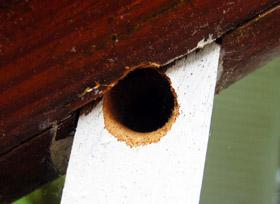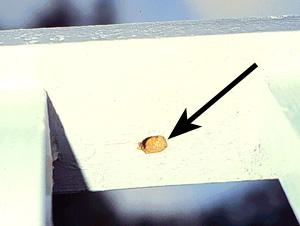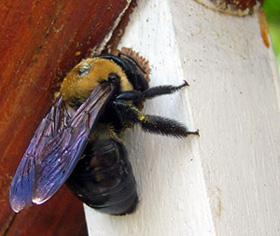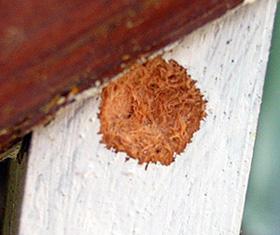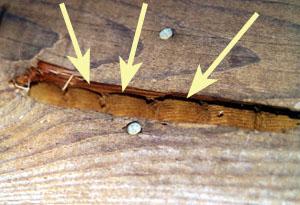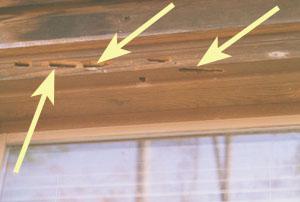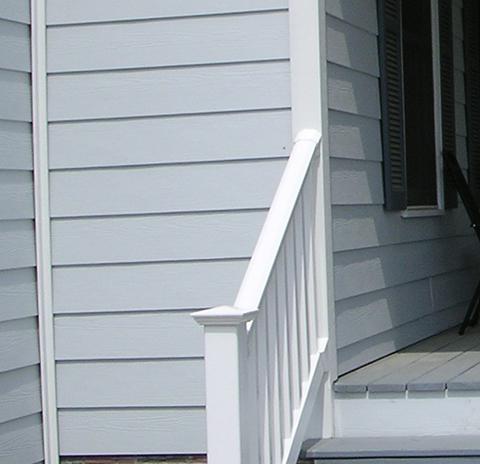Introduction
Carpenter bees (Figure 1) are large, black and yellow bees frequently seen in spring hovering around the eaves of a house or the underside of a deck or porch rail. They are often mistaken for bumble bees, but differ in that they have a black shiny tail section.The carpenter bee is so-called because of its habit of excavating tunnels in wood with its strong jaws. The round half-inch diameter entrance holes (Figure 2) are usually found on the underside of a board. A tell-tale trace of coarse sawdust is often found on the surface beneath the hole. Wooden decks, overhangs and other exposed wood on houses are prime targets. Painted and treated woods (Figure 3) are less preferred, but they are by no means immune to attack.
Unpainted or stained cedar, cypress and redwood shingles and siding are also attacked despite their pest-resistant reputations. Carpenter bees, like their distant relatives, the carpenter ants, differ from termites in that they do not eat wood as food. They simply excavate tunnels for nesting sites.
Biology
Carpenter bees overwinter as adults, often inside old nest tunnels. They emerge in April and May with the males usually the first to appear. Males can be distinguished from females by a whitish spot on the front of their face. The males do not have stingers, but they are territorial and will harass other carpenter bees and people who are near their nesting areas. Females can sting, but rarely do so unless confined in your hand or become highly agitated. Unlike bumble bees and honey bees, carpenter bees are "solitary bees", i.e., they do not form colonies with worker bees to maintain a nest or care for offspring. The mated female bees feed on plant nectar and then begin constructing new tunnels in a few weeks. The entrance holes start upward (or inward) for about one-half inch or more (Figure 4 and Figure 5), then turn horizontally and follow the wood grain. The galleries typically run six to seven inches, but may exceed one foot. Occasionally, several bees use the same entrance hole, but they have individual galleries branching off of the main tunnel. If the same entrance hole is used for several years, tunnels may extend several feet in the wood. Inside her gallery. The female bee collects pollen which she mixes with nectar to form a ball that will serve as food for her offspring. She deposits an egg near this pollen ball and then seals off this section of tunnel with a partition made of chewed wood. She constructs additional cells in this manner until the tunnel is completely filled, usually with six to seven cells (depending on length of the tunnel) (Figure 6). These adult bees die in a matter of weeks. The eggs hatch in a few days and the offspring complete their development in about 5 to 7 weeks. The new generation of adult bees begin to emerge in later summer. Although the bees remain active, feeding on pollen the general area, they do not construct new tunnels, but may be seen cleaning out old tunnels which they will use as overwintering sites when the weather turns cold.
Damage Caused by Carpenter Bees
Typically, carpenter bees do not cause serious structural damage to wood unless large numbers of bees are drilling many tunnels over successive years. The bees often eliminate their wastes before entering the tunnel. Yellowish-brown staining from voided fecal matter (Figure 7) may be visible on the wood beneath the hole as seen in the picture above. Woodpeckers may damage infested wood in search of bee larvae in the tunnels (Figure 8). In the case of thin wood, such as siding, this damage can be severe. Holes on exposed surfaces can allow rainwater to enter the wood which could lead to damage by wood-decaying fungi or attack by other insects, such as carpenter ants.
Control
Preventing carpenter bee damage is difficult (or nearly impossible) for several reasons. Protective insecticide sprays applied to wood surfaces are effective for only a short period even when repeated every few weeks. Since the bees are not actually eating the wood and they are active over several weeks, they may not be exposed to lethal doses of the pesticide. Second, since virtually any exposed wood on the house could be attacked, it is difficult and usually impractical and unsafe to try applying a pesticide to all possible sites where the bees might tunnel. Trying to spray bees that are seen hovering about is not a sensible (or particularly safe) use of pesticides either. Swatting hovering bees will often prove to be just as effective.
Although it is a time-consuming and seemingly endless task, treating the entrance holes with an insecticidal spray or dust can reduce future nesting activity. Products containing carbaryl (Sevin), cyfluthrin or resmethrin among other chemicals are suitable. A list of chemicals for use against carpenter bees can be found in the North Carolina Agricultural Chemicals Manual. Avoid inhaling the insecticide or contaminating your clothing with the spray. Always stand upwind from the surface you're treating. Treated tunnels should be sealed with a small ball of aluminum foil and caulked after 24-36 hours. Since active or abandoned tunnels may be used as overwintering sites or can be re-used next spring for nesting, it is important that they be sealed. The insecticide treatment is important because it kills both the adult bee as well as any offspring as they attempt to emerge later. Simply plugging untreated tunnels with wire mesh or similar material might trap bees inside, but more resourceful bees will simply chew another exit hole.
Another option is to go the route of replacing wood siding with composite materials (such as masony, cement board siding, or vinyl siding) as well as replacing porch rails and balusters. For some people, these alternatives are not always preferred from an aesthetic or cost perspective.
For assistance with a specific problem, contact your local Cooperative Extension center.
Publication date: July 1, 2018
The use of brand names in this publication does not imply endorsement by NC State University or N.C. A&T State University of the products or services named nor discrimination against similar products or services not mentioned.
Recommendations for the use of agricultural chemicals are included in this publication as a convenience to the reader. The use of brand names and any mention or listing of commercial products or services in this publication does not imply endorsement by NC State University or N.C. A&T State University nor discrimination against similar products or services not mentioned. Individuals who use agricultural chemicals are responsible for ensuring that the intended use complies with current regulations and conforms to the product label. Be sure to obtain current information about usage regulations and examine a current product label before applying any chemical. For assistance, contact your local N.C. Cooperative Extension county center.
N.C. Cooperative Extension prohibits discrimination and harassment regardless of age, color, disability, family and marital status, gender identity, national origin, political beliefs, race, religion, sex (including pregnancy), sexual orientation and veteran status.


